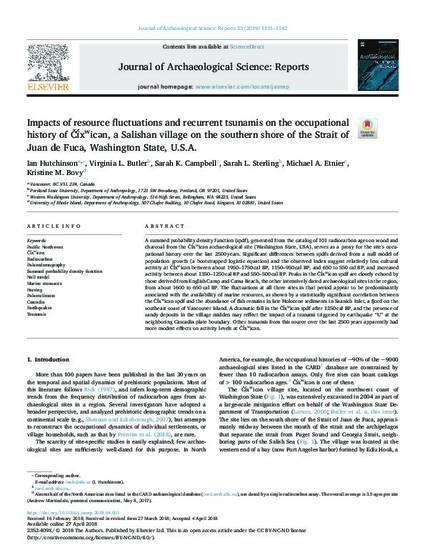
- Pacific Northwest,
- Čḯxwicən,
- Radiocarbon,
- Palaeodemography,
- Summed probability density function,
- Null model,
- Marine resources,
- Herring,
- Palaeoclimate,
- Cascadia,
- Earthquakes,
- Tsunamis
A summed probability density function (spdf), generated from the catalog of 101 radiocarbon ages on wood and charcoal from the Čḯxwicən archaeological site (Washington State, USA), serves as a proxy for the site's occupational history over the last 2500 years. Significant differences between spdfs derived from a null model of population growth (a bootstrapped logistic equation) and the observed index suggest relatively less cultural activity at Čḯxwicən between about 1950–1750 cal BP, 1150–950 cal BP, and 650 to 550 cal BP; and increased activity between about 1350–1250 cal BP and 550–500 cal BP. Peaks in the Čḯxwicən spdf are closely echoed by those derived from English Camp and Cama Beach, the other intensively dated archaeological sites in the region from about 1600 to 650 cal BP. The fluctuations at all three sites in that period appear to be predominantly associated with the availability of marine resources, as shown by a statistically significant correlation between the Čḯxwicən spdf and the abundance of fish remains in late Holocene sediments in Saanich Inlet, a fjord on the southeast coast of Vancouver Island. A dramatic fall in the Čḯxwicən spdf after 1250 cal BP, and the presence of sandy deposits in the village midden may reflect the impact of a tsunami triggered by earthquake “U” at the neighboring Cascadia plate boundary. Other tsunamis from this source over the last 2500 years apparently had more modest effects on activity levels at Čḯxwicən.
Available at: http://works.bepress.com/sarah-campbell/55/
